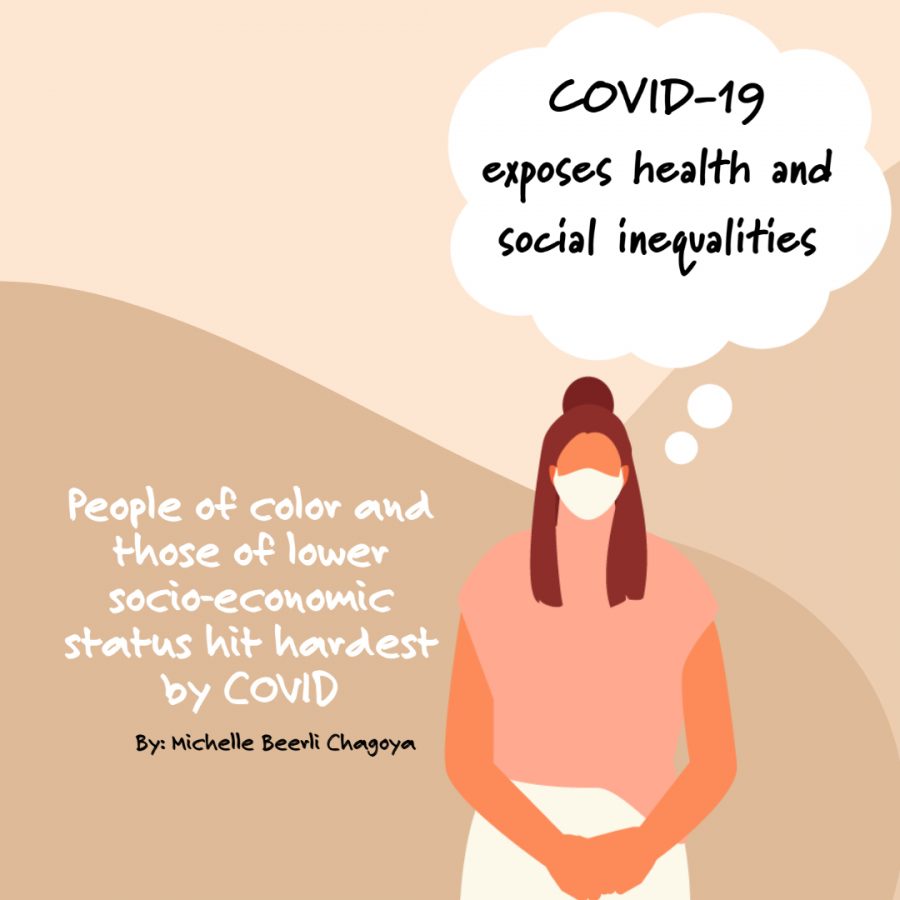COVID-19 exposes health and social inequalities
People of color and those of lower socio-economic status hit hardest by COVID
March 9, 2021
COVID-19 has impacted everyone’s lives. We’ve all had to face challenges and bear the burden of the pandemic. According to the CDC Covid tracker as of March 4, the United States is leading with the highest numbers in the world, with over twenty eight million confirmed cases and over five hundred thousand confirmed deaths. The data also shows that communities of color are disproportionately affected by COVID-19 across the United States which has shone a spotlight on long standing systemic social inequalities in healthcare.
According to NPR, findings consistently show that people of color are impacted most by COVID-19 at every stage, from risk of exposure, to access to testing, to severity of the illness and eventually death. This data has made it impossible to ignore the disproportionate infection rates of racial and ethnic minority groups, not just with COVID-19, but with various health ailments.
Based on research by Harvard University and published on their website, “if you were to adjust the mortality data for these vulnerable populations such that they were instead dying at the rate at which White people are dying, you would find that roughly 19,500 Black, 8,400 Latinx, 600 Indigenous, and 70 Pacific Islander Americans would still be alive right now.”
Some experiences are common to many people within these groups, and social determinants of health have historically prevented them from having fair opportunities. Discrimination, healthcare access, occupation, education, income/wealth gaps, and housing all contribute to increased risk.
“A lot of elderly in my community, even people I knew, have died of COVID,” said senior Felix Echols who identifies with the Filipino community. “I think it’s because a lot of Filipinos are essential workers, and are unable to stop working during the pandemic. You will see a lot of elderly Filipinos here working at highly populated places like Lynnhaven Mall, Walmart, and schools.”
Echols also noted that, “Filipinos make up 4% of nurses, but account for 31.5% of nurse deaths.”
U.S. Census Bureau data from 2019 revealed differences in occupation prevalence within each racial/ethnic group, stating that compared with Whites, Blacks and Latinos were more likely to work in jobs considered essential. In fact, to some people of these communities, social distancing is a privilege that they cannot afford because they aren’t able to work from home. Even if that was a possibility, people of color are more likely to live in densely populated areas, making it all the more difficult to follow social distancing protocols.
Senior Anna Watson, who identifies with the Hispanic community felt the impact of COVID first hand.
“Covid has impacted both my immediate family and my distant family,” said Watson. “My mom is an emergency room nurse and has to deal with COVID first hand, with 7 to 10 patients every day that she’s coming in contact with. Also, my distant family who is Hispanic all got COVID and one of them had bilateral pneumonia because of it; thankfully he recovered.”
A systemically entrenched problem of health inequality has continually become more apparent over the past year.
“I knew that statistically Hispanics are more likely to be hospitalized than Caucasian people, so it wasn’t too much of a surprise that [a family member] ended up being hospitalized,” said Watson.
The pandemic did not create these problems of inequality, but it has served as a spotlight on them. The conversations forward based on the health inequity data brought forth by the COVID crisis may lead to finding better ways to help marginalized populations.
“It’s sickening that basic human rights are commodified, and the things we need to survive are the most expensive,” said Echols.
To learn more about health inequities among minority groups in the United States check out these sources:
From the CDC: Health Equity Considerations and Racial and Ethnic Minority Groups
From WebMD: INVESTIGATING THE GAP IN HEALTH CARE FOR MINORITIES
From NPR: What Do Coronavirus Racial Disparities Look Like State By State?
From the Mayo Clinic: Why are people of color more at risk of coronavirus complications?


drmkchr • Mar 17, 2021 at 6:18 am
Very well written and well researched. I appreciate seeing citations at the end of the article, something you so rarely see anymore. Frankly some of the writing I’m seeing in this newspaper is better than many of our local news outlets!